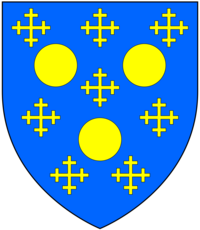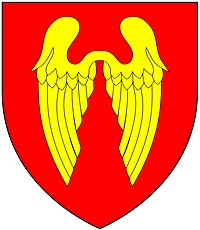Devon heraldry
The standard sources for the heraldry of Devon are as follows:
- Heraldic visitations of Devon: Vivian, Lt.Col. J.L., (Ed.) The Visitation of the County of Devon: Comprising the Heralds' Visitations of 1531, 1564 & 1620, Exeter, 1895.
- Pole, Sir William (d.1635), Collections Towards a Description of the County of Devon, Sir John-William de la Pole (ed.), London, 1791, pp.444-467, "The Armes of such nobles and gentlemen which have anciently dwelled & had lands in Devonshire"; pp.467-510, "An alphabet of the armes of the gentlemen of Devonshire as well of those being as of those which have bine"
- The Notebook of Tristram Risdon (d.1640)[1]
- Lysons, Magna Britannia, Volume 6: Devonshire, London, 1822
- Observation of surviving monuments in parish churches and mansion houses.
Frequently discrepancies between these sources exist. Painted monuments in parish churches often have been restored, in some cases several times over the centuries, and the arms depicted may not be as originally painted. Heraldry sculpted in relief on stone is liable to wear and crumbling, especially when placed in the favourite location, exposed to the elements for centuries, on the porch or gatehouse of the family mansion. Ancient monumental brasses do not show tinctures but otherwise provide lasting records of heraldry. Stained glass depictions are optimal sources as they include tinctures, but ancient survivals are rare. Mural monuments placed high up on walls generally survive vandalism of past ages whilst paintings of arms on escutcheons sculpted in stone on mediaeval chest tombs have rarely survived and often were "scraped" clean of all decoration in the 17th century. Heraldic monuments displaying a family's arms are generally found in the church of the parish in which is situated their seat, but the paternal arms may also be found in remoter parish churches where a daughter of the family has married into a family resident there. In such a case the arms are shown impaled by the arms of her husband. Clearly the greatest problems in tracing heraldry relate to long extinct families. A few ancient Devon families survive, such as the Fortescues, and a flag showing the Fortescue arms still flies above Castle Hill in 2013. There is no shortage of surviving examples of the arms of the Chichesters and Rolles, but surviving heraldry of the ancient Courtenay Earls of Devon seated at Tiverton Castle is rare, although frequently shown as quarterings in the arms of related families.
The following armorials are listed in the Heraldic Visitations of Devon:[1]
| Name | Escutcheon | Blazon | Seats |
|---|---|---|---|
| Acland | 
|
Chequy argent and sable, a fesse gules | Acland Barton, Landkey; Holnicote, Somerset; Killerton, Devon |
| Adams | 
|
Or, a lion rampant between six crosses crosslet within a bordure engrailed sable | Tunstall, Devon;Charlton Adam, Somerset |
| Amory | 
|
Barry nebulé of six argent and gules, over all a bend azure | Whitechapel, Bishops Nympton |
| Arscott | 
|
Per chevron azure and ermine in chief two buck's heads cabossed or | Arscott, Holsworthy;[2]Dunsland, Bradford; Tetcott; Annery, Monkleigh |
| Ayshford | 
|
Argent, between two chevrons sable three ashen keys vert | Ayshford, Burlescombe |
| Bampfield | 
|
Or, on a bend gules three mullets argent | Poltimore; North Molton |
| Barry | 
|
Barry of six argent and gules | Winscott, St Giles in the Wood |
| Basset | 
|
Barry wavy of six or and gules | Whitechapel, Bishops Nympton; Umberleigh; Heanton Punchardon; Watermouth Castle |
| Beaumont | 
|
Barry of six vair and gules | Youlston, Shirwell; Gittisham |
| Bellew | 
|
Sable fretty or | Stockleigh English; Ash, Braunton |
| Berry | 
|
Or, three bars gules | Berrynarbor |
| Blewett | 
|
Or, a chevron azure between three eagles displayed of the last | Holcombe Rogus |
| Bonville | 
|
Sable, six mullets argent pierced gules | Shute |
| Bourchier | 
|
Argent, a cross engrailed gules between four water bougets sable | Tawstock; Bampton |
| Burgoyne | 
|
Azure, a hound passant argent | South Tawton |
| Calmady | 
|
Azure, a chevron between three pears or | Calmady, Penfound, Poundstock, Cornwall;Langdon, Wembury; Stoke Climsland, Cornwall; Leawood, Bridestowe; |
| Carew | 
|
Or, three lions passant sable | Crowcombe; Antony, Cornwall; Tiverton Castle; Haccombe; Bickleigh Castle |
| Champernowne | 
|
Gules, a saltire vair between twelve billets or | Modbury; Bere Ferrers; Dartington; Ilfracombe |
| Chichester | 
|
Chequy or and gules, a chief vair | Raleigh; Eggesford; Hall; Arlington; Youlston |
| Clifford | 
|
Chequy or and azure a fess gules | Chudleigh |
| Coffin | 
|
Azure, three bezants between eight crosses crosslet or | Portledge, Alwington; Monkleigh; Inwardleigh |
| Courtenay | 
|
Or, three torteaux | Okehampton; Tiverton; Powderham; Molland; Colcombe Castle |
| Culme | 
|
Azure, a chevron ermine between 3 pelicans vulning their breasts or | Molland; Canonsleigh Abbey |
| Denys/Dennis | 
|
Ermine, three battle-axes gules | Holcombe Burnell; Bicton |
| Denys/Dennis | 
|
Azure, three Danish battle axes erect or | Orleigh |
| Drake | 
|
Argent, a wyvern gules | Ash, Musbbury |
| Duke | 
|
Per fesse argent and azure, three chaplets counterchanged | Otterton |
| Ford | 
|
Party per fesse or and sable, in chief a greyhound courant in base an owl within a bordure engrailed all counter-changed | Nutwell; Chagford; Ashburton; Bagtor, Ilsington |
| Fortescue | 
|
Azure, a bend engrailed argent cotised or | Wimpstone, Modbury; Castle Hill, Filleigh; Weare Giffard; Fallapit, East Allington; Buckland Filleigh; Preston, Devon; |
| Giffard | 
|
Sable, three fusils conjoined in fesse ermine | Brightley, Chittlehampton; Tiverton Castle; Halsbury, Parkham |
| Hancock | 
|
Gules, on a chief argent three cocks of the field | Combe Martin |
| Hooker alias Vowell | 
|
Or, a fess vair between two lions passant guardant sable | St Mary Major, Exeter |
| Mallet | 
|
Azure, three escallops or[3] | Iddesleigh; Wooleigh, Beaford |
| Martyn | 
|
Argent, two bars gules[4] | Feudal barony of Barnstaple; Oxton, Kenton; Lindridge |
| Monk | 
|
Gules, a chevron between three lion's heads erased argent | Great Potheridge, Merton |
| Northcote | 
|
Argent, three crosses-crosslet in bend sable | Northcote, East Down; Newton St Cyres; Pynes, Upton Pyne |
| Parker | 
|
Sable, a stag's head cabossed between two flaunches argent | North Molton; Boringdon; Saltram; Whiteway, Chudleigh |
| Pole | 
|
Azure semé of fleurs de lis or, a lion rampant argent | Shute; Colcombe Castle |
| Pollard | 
|
Argent, a chevron sable between three escallops gules[5] | Way, St Giles in the Wood; Grilston, Bishop's Nympton; King's Nympton; Langley, Yarnscombe; Abbots Bickington |
| Popham | 
|
Argent, on a chief gules two stag's heads cabosed or | Lynton |
| Prideaux | 
|
Argent, a chevron sable in chief a label of three points gules | Prideaux, Cornwall; Adeston, Holbeton; Thuborough, Sutcombe; Solden, Holsworthy; Netherton, Farway; Ashburton; Nutwell, Woodbury |
| Prust | 
|
Gules, on a chief argent two estoiles sable | Thorry, Hartland; Gorven, Hartland; Annery, Monkleigh |
| Raleigh | 
|
Gules crusilly or, a bend vair or Gules, a bend vair between six crosses crosslet or | Raleigh, Pilton; Fardell, Cornwood |
| Reynell | 
|
Argent, masonry sable a chief indented of the second | Forde, Wolborough; East Ogwell |
| Risdon | 
|
Argent, three birdbolts sable | Winscott, St Giles in the Wood; Bableigh, Parkham |
| Rolle | 
|
Or, on a fesse dancette between three billets azure each charged with a lion rampant of the first three bezants | Stevenstone; Bicton; Hudscott, Chittlehampton; Beam, Great Torrington |
| Seymour | 
|
Gules, two wings conjoined in lure or | Berry Pomeroy |
| Shapcott | 
|
Sable, a chevron (or[6]) between three dovecotes argent | Shapcott, Knowstone |
| Stucley | 
|
Azure, three pears or | Affeton Castle; Hartland Abbey |
| Upton | 
|
Sable, a cross flory argent | Puslinch; Lupton |
| Walrond | 
|
Argent, three bull's heads cabossed sable armed or | Bradfield, Uffculme; Bovey House, Beer |
| Worth (Wrothe) | 
|
Argent, an eagle with two heads displayed sable beaked and legged gules | Worth, Washfield, near Tiverton |
See also
Notes
- ^ Vivian 1895.
- ^ Hoskins, p.411
- ^ Mallet of Idsleigh (Vivian 1895, p. 545); as visible on monument to Sir Arthur Acland (d.1610) in Landkey Church
- ^ As generally blazoned; Vivian 1895, p. 552, Martyn of Oxton, gives three bars
- ^ Arms of Pollard of Horwood: A chevron between three mullets pierced (visible in Horwood Church)
- ^ As depicted in stained glass in east window of Shute Church, Devon, impaled by arms of Pole of Shute, representing the marriage of Sir Courtenay Pole, 2nd Baronet (1619-1695) and Urith Shapcott, daughter of Thomas Shapcott of Shapcott in the parish of Knowstone, Devon. Elsewhere the arms are shown with a chevron or (Barnstaple Church on Tucker monument), or without chevron (in Knowstone Church). (Pole (Vivian 1895, pp. 603), Shapcott (Vivian 1895, pp. 677), blazoned with chevron or)
